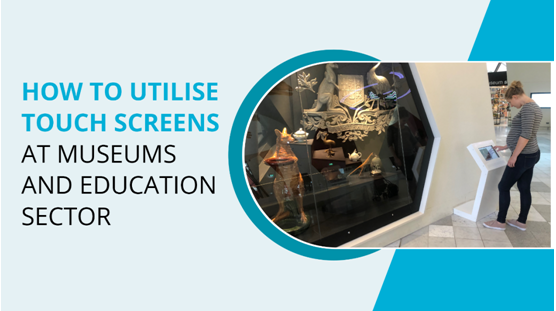How to Utilise Touch Screens at Museums and Education Sector
Historically, museums were considered boring places, especially for children. People used to wade through glass cabinets and read through faded information pages. There were no engaging activities for visitors to interact with. Therefore most ordinary people used to back off from museum visits.
The introduction of touch screens for museums has revolutionised this idea. The axiom ‘look but do not touch’ is long forgotten, now, museums and even education sectors are embracing the idea of hands-on experience through touch screen monitors.
How to use a touch screen monitor in museums?
Showcase information and guide visitors
This is one of the most common use kiosk touch screens in museums. The touch screens can display information in a creative and visually appealing way.
Create animated videos, share artists’ notes, and offer detailed information about your artefact.
Before touch screens, the amount of information you got depended on how much knowledge the guide had, so the chances of misinformation were also high.
Museums can now offer precise information along with the options of different formats with a touch screen monitor. Visitors can now choose from audio, video, or written reports of the artefact.
Bring the artefact closer to visitors
Sometimes museums cannot acquire some artefacts because of legal reasons, transport unavailability, wear and tear problems, space shortage, or increasing insurance.
Touch screen kiosks Australia can solve this issue. Museums can use touch screen monitors to display products and let people view them from different angles. Visitors can get information even if your artefact is hundreds of miles away.
Allow people to find artefacts
In large museums, people often get lost. Touch screen monitors at different locations can guide visitors to stay on track and find their way back.
History of the artefacts
People want to understand the context when they are viewing an exhibit. Touch screens can take them on a 3D virtual tour to the place of origin and show them videos. Hence, visitors can interact and feel more interested.
Touch screens can take visitors to Rome and allow them to discover various regions through the touchscreen monitor as an example.
Boost visitor engagement
People, especially kids, like to learn at their own pace. When visitors access information through touch screens, they will absorb the details at their own pace. Visitors can revisit the written data, listen to the audio again, or rewatch the video.
Buy souvenirs
When museums display many artefacts, the space for souvenirs shrinks and causes dissatisfaction among visitors. Often gifts or souvenirs are out of stock.
Using touch screen solutions, you can allow visitors to explore and select from a wide range of gifts. Therefore, your museum will be saving space and money.
Additionally, with touch screen monitors visitors can deliver the selected souvenirs to their home address and let them roam free-handed across the museum.
How to utilise a touch screen monitor in the education sector?
Announcements
Due to the yearly introduction of new syllabuses, results, events, and demonstrations, information display sections in education sectors are always changing.
Kiosk touch screen solution makes it unnecessary to revamp or completely replace traditional signage to provide the most recent information.
To keep visitors informed about various study-related announcements and other pertinent information the touch screen technology can display any announcement. The information can be shared with visitors as well as with employees. The touch screens can also be maintained and precisely presented.
Increase interactivity
Attracting younger students and a new generation of potential volunteers is becoming increasingly difficult for education sectors. A particularly effective strategy for attracting new students to attend school and college regularly is to use technology to make the experience more hands on.
Bolster active participation
Active learning, as the name suggests, involves interaction with the material through participating in the educational process. Experienced instructors are not surprised active learning functions so well.
Many activities are improved when teachers and students use interactive whiteboards, stimulating active learning.
The purpose of interactive touch screen displays is to support active learning. Touch screens are one of the biggest benefits for the classroom when students are participating in active learning.
Enable student-led learning
To recognise when students are on the correct road, they need feedback. Years of research have demonstrated that improved learning is produced by combining less instruction with more feedback. In fact, feedback doubles the rate of learning for students.
When kids have access to technology, small group conversations allow for a creative boost. Tech-savvy students will use the available gadgets to conduct research, create diagrams, drawings, descriptions, and arguments.
Students can continuously offer reviews and feedback on one other’s ideas and comprehension throughout the touch screen monitor.
Encourage inclusivity
Teachers can provide more learning opportunities to more pupils with the use of interactive touch screen monitors.
Kinesthetic learners, for example, can get up and move during lessons that require students to come to the board. Visual and auditory learners enjoy watching videos and listening to multimedia presentations.
Students that learn best by reading, teachers can take, save, and give out on-screen notes for independent assessment.
Make learning outcomes better
Touch screen monitors are entertaining. Touch screens enthral, lengthen attention spans, and increase student involvement. Plus, they can serve as an excellent foundation for cohesiveness in the classroom.
Touch screens are also a tried-and-true method of assisting kids in learning, and allow students to apply their information as they proceed in life.
Teachers can also make use of interactive displays’ learning potential. The displays themselves provide a higher level of interaction and collaboration. The numerous cutting-edge interactive learning apps can be added to enhance students learning.
Conclusion
Museums and education centres are valuable parts of any country. The more people like to attend museums, the more they will become knowledgeable. To bring in visitors time and again is a challenge that an industrial touch screen monitor can solve.


